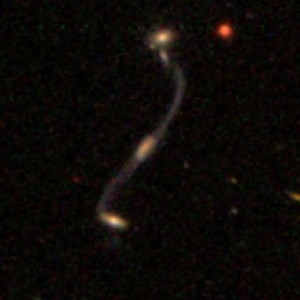AVAO wrote: ↑Sat Jan 14, 2023 6:30 am
johnnydeep wrote: ↑Fri Jan 13, 2023 9:48 pm
AVAO wrote: ↑Fri Jan 13, 2023 3:54 pm
Star or binary star system with jets?
Background galaxy with one or two cores?

That is indeed one very nice looking - possibly two-cored - background galaxy! Nice spotting Ann and AVAO.
Hmmm. I was unsure and have checked it again more detailed:
The "jets" or "arms" are invisible in the optical spectral range. The visible "arms" in the HST are probably from HST WFC F814W. The fact that the upper arm appears to be in front of the dust filament in the JWST image is therefore apparently a misleading effect resulting from the overlapping of the wavelengths. In the blue channel of the HST image, the arms are practically invisible. The "second" or "middle" galactic core only becomes visible in the infrared. But I'm still not 100% convinced, because the "main core" is also very good visible in the optical area and appears there as a "star". Unfortunately, the JWST data are not yet public, so that no more detailed analyzes are possible here.
Thanx Ann
Now our analyzes have overlapped in time. But it's nice that we get quite the same result

I think that maybe, maybe, the galaxy(?) seen in the picture of NGC 346 is a second cousin of the merging galaxies, IC 1178 and IC 1181, in the Perseus Cluster of galaxies:
Dry merger in the Perseus Cluster.
Credit: Detlef Hartmann.
IC 1178 and IC 1181 are two elliptical or lenticular galaxies in the Perseus Cluster of galaxies. IC 1178 and IC 1181 contain no "concentrated dust clouds of dust lanes" at all, and no concentrated gas clouds. As they merge, they produce no new stars at all (which is why it is called a dry merger), but they produce two tidal tails of flung-out old stars. The tidal tails are reminiscent of spiral arms.
Let's assume that the object that resembles a galaxy in the picture of NGC 346 really
is a galaxy. Is it strange that we only detect it in infrared light?
I think not. If this galaxy, like IC 1178 and IC 1181, is made up almost exclusively of old stars, then the light that it emits will be intrinsically yellow. Let's assume, too, that the galaxy is sufficiently distant to be appreciably reddened by cosmological redshift. On top of that, let's assume that the galaxy is quite dust-reddened by all the dust that is present in and near NGC 346.
These three factors combined make it quite reasonable to assume that the galaxy (or at least the faint arms) will only be visible in infrared light.
Ann
 Young Star Cluster NGC 346
Young Star Cluster NGC 346




